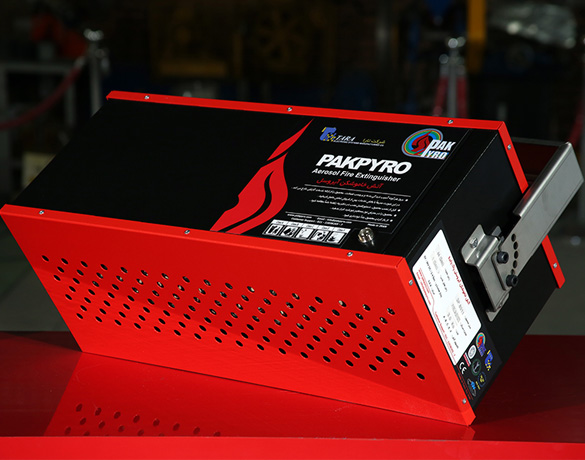
Gas fire extinguishing systems have been used since the early 1930s. It was welcomed at the time for the lack of alternative solutions. However, over time, problems with its use challenged the technology, and inventors sought to introduce new technology to improve the performance of firefighting systems and solve their problems.
Some of the disadvantages of using gases are as follows:
- Effect on fire by reducing the concentration of oxygen in the area: Therefore, the fire extinguishing system is an ideal system that does not reduce the volume of oxygen in the environment and does not endanger the health of people if activated.
- Due to the fact that the extinguishing gas in the capsules is under pressure, so when leaving and facing the ambient pressure, carbon dioxide will be required to take the temperature of the environment in order to increase the distance between the molecules. Therefore, during evacuation, the ambient temperature will decrease significantly, which will damage the equipment located in the environment: Therefore, the ideal fire extinguishing system is a system that does not cause a sudden change in ambient temperature.
- Greenhouse gases destroy the ozone layer and increase the Earth’s temperature. (ODP = 1, GWP = 1) It should be noted that greenhouse gases are a measure of the rate of ozone depletion and global warming, so ODP and GWP consider it one. Therefore, the ideal fire extinguishing system is a system that has the least degradation on the ozone layer and the Earth and has a minimum durability in its environment, because with its production and consumption in the world, its concentration in the atmosphere will continuously increase.
- The use of pressurized cylinders is itself a threat to the environment in which it is installed. On a daily basis, we see the explosion of such capsules in all parts of the world. The cause of their explosion is due to various reasons such as the occurrence of an earthquake, direct exposure to the flame, damage to the valves and its body by accidental manpower and so on. However, there are very strict rules regarding the production of such tanks in various standards.Therefore, in the by-laws approved by the country’s passive defense committee, laws have been passed regarding the non-installation of pressure vessels near facilities that have a security category. This threat applies not only to places with a security rating, but also to all public places and expensive equipment. Therefore, the ideal fire extinguishing system is a system that does not use such tanks as much as possible.
- The number of required tanks and related piping occupies one part of the environment and makes another part unusable. This will be more pronounced in places where space is limited, which will cause other problems that may not have seemed so at first. Therefore, the ideal fire extinguishing system will be a system that occupies the least possible space.
- Production of HF (halogen acid) during molecular decomposition in the face of temperatures above 500 ° C, which will have a very dangerous and deadly effect. Therefore, the ideal fire extinguishing system will be a system that does not change its nature in the face of high temperatures.
A revolution is taking place in the fire extinguishing system
Aerosol, which uses rocket solid fuel technology,
The world’s first commercially manufactured solid-particle fire extinguishing system (aerosol) designed as a safe and practical alternative to halo, halocarbons, chemical powders and inert gases.
Aerosol is commercially produced and available in tanks with different capacities.
Solid aerosol is non-toxic and inert and remains stable until it is electrically or thermally activated, and when activated, it produces a combination of solid micro-sized particles (aerosol) with high extinguishing properties.The aerosol physically and chemically attacks the fire, instantly extinguishing the fire and preventing it from flare up again (and in real conditions from exploding). In many applications, the aerosol is the only practical alternative to halon and gases. It is neutral.
The idea of fire extinguishing is unique in this system, a solid chemical, when stimulated electrically or thermally, creates a combination of solid micron-sized micron-sized particles of dry matter.
Dry chemical particles (mostly potassium carbonates) and a mixture of gases (mostly carbon dioxide, nitrogen, and water vapor) mix together to form a unique extinguishing aerosol.
Before the aerosol spreads to the covered area, the aerosol particles pass through a coolant and reduce the aerosol temperature optimally and help to distribute the material evenly in the environment.
The very high velocity of the aerosol discharge will have an instantaneous effect in extinguishing the fire. The aerosol microparticles act like a cloud and scatter in all dimensions, allowing the extinguishing agent to diffuse rapidly and penetrate far from the most accessible and obscure points.
Uniform diffusion occurs in less than a few seconds and long shelf life will prevent re-ignition.
In addition, in the standard and in theory, it will not have any detrimental effect on human health, the environment and equipment. So far, there have been no reports of damage in practice.
Advantages and features of the aerosol system
Lightweight and compact & Compact & Weight Saving
Installation without complexity and quick restart Simple to install & Recommission
Non-toxic Low Toxicity
Economical and cost effective
3 times more effective than Halon
Environmentally Friendly
No need for piping and pressure vessels No pressurized Cylinders or pipe work
Application of aerosol system
Computer Room Computer Room
Electrical Substation Distribution System
Generator Room
Raised Floor
Server Farm Server Room
Warehouse
Telecommunication Cabin
Control Room Control Room
CNC Machine CNC Machine
Computer Server Rack
Electrical switchboard Distribution Board
Oil & Gas Industries
Ports & Ships Ports & Ships & Boats
And…
